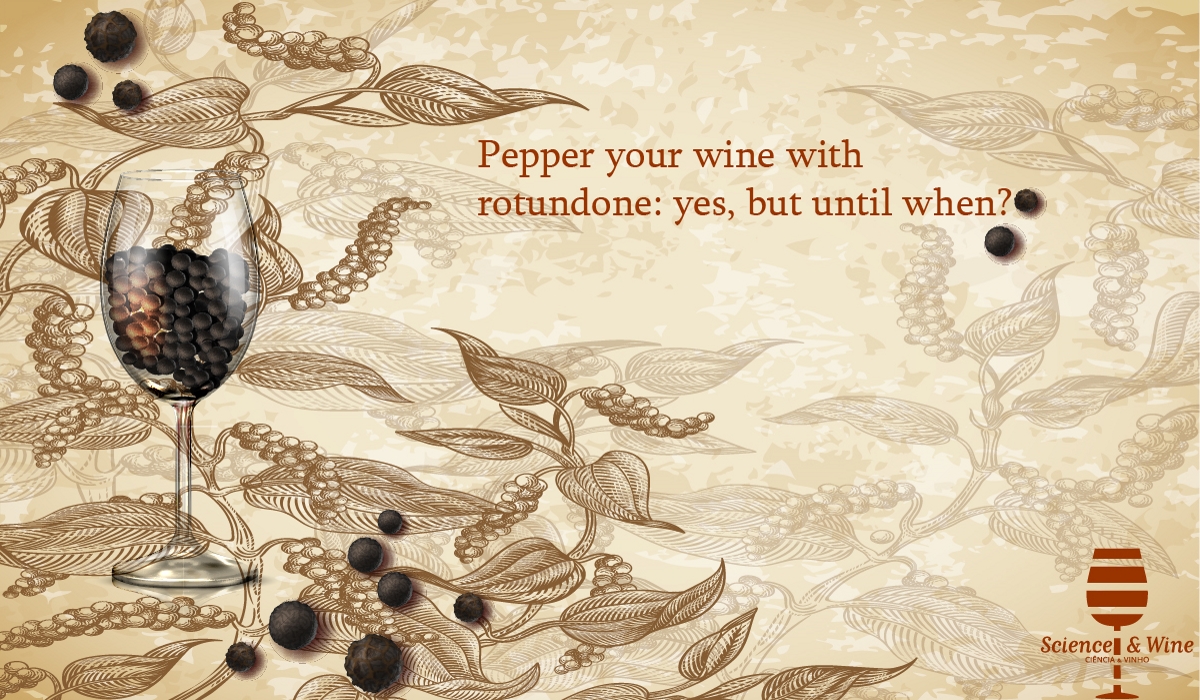By Olivier Geffroy
Wine is a complex matrix which contains more than 800 aroma compounds. Most of the contributors to the varietal aroma of white wines such as monoterpenols responsible for floral notes in Muscat varieties or varietal thiols imparting grapefruit and tropical fruit notes to Sauvignon blanc wines, have been widely studied. Knowledge on odorants accounting for the varietal character of red wines especially free aroma compounds, were limited to vegetal and undesirable aroma compounds named methoxypyrazines before the discovery of rotundone (Wood et al. 2008).
This oxygenated sesquiterpene (Figure 1) still relatively little studied across the world, is responsible for pepper aroma in grapes and wine. It has a detection threshold of 16 ng/L in red wine and was described as one of the most impacting volatile molecules in wine (Ferreira et al. 2012). Specific anosmia to rotundone has been reported with 20-30% of the panelists being unable to detect it even at very high concentration levels (Wood et al. 2008, Geffroy et al. 2018).
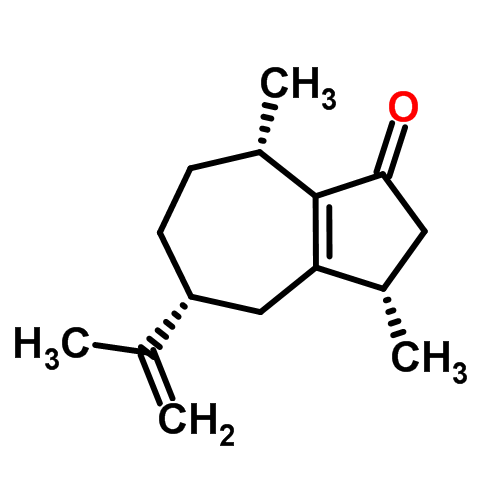
In most cases, rotundone is positively perceived by consumers (Geffroy et al. 2018) and those who appreciate peppery wines are generally wine connoisseurs who pay more money for a bottle of wine than the average consumer (Geffroy et al. 2016). This makes rotundone aroma highly desirable in cultivars in which it has been identified such as Syrah, Pinot noir, Gamay or Duras. Two key polymorphisms in a newly discovered allele of the V. vinifera TPS24 gene may explain the differences in rotundone expression observed between cultivars (Drew et al. 2016).
As other sesquiterpenes, rotundone could be involved in plant defense mechanisms (insect repellent or attractant, inhibitory effect against fungi). In this regard, Geffroy et al. (2015) identified a positive logarithmic correlation between rotundone concentration and the severity of powdery mildew on bunches (Figure 2) which suggests that the compound could be produced in response to the fungal infection.
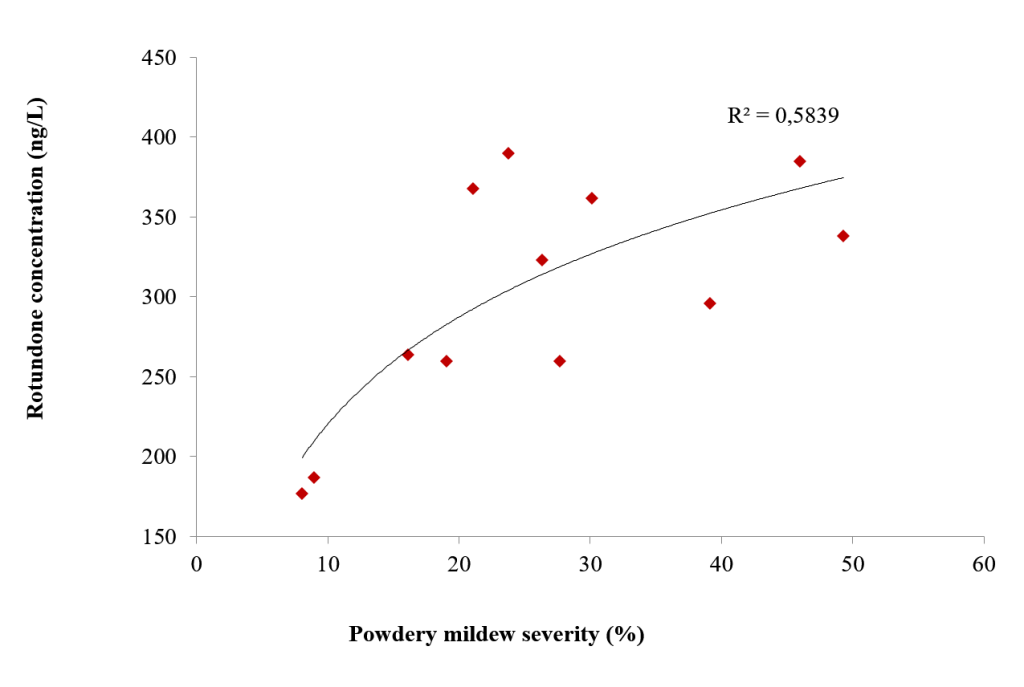
Rotundone concentration increases with the ripening of the fruit (Geffroy et al. 2014) and is highly impacted by vintage conditions and environmental factors. Cool and wet vintages promote the production of red wines with a higher rotundone concentration (Caputi et al. 2011). Bunch zone air and surface temperatures (Zhang et al. 2015) and vine water status over the veraison–harvest period (Geffroy et al. 2014) were identified as key variables to explain differences in rotundone between vintages and within one single vineyard. In accordance with these findings, rotundone was lowered by bunch exposure through leaf removal performed on both sides of the row and enhanced by water supply through irrigation (Geffroy et al. 2014).
In an attempt to optimize rotundone in wine during grape processing, Geffroy et al. (2017) studied the impact of winemaking techniques and fermentation variables on the molecule. None of the studied treatments including the use of macerating enzymes and the increase of temperature or time of maceration resulted in enhanced rotundone concentration. This is not an uninteresting conclusion as it means that efforts to maximize rotundone in wine have to be undertaken in vineyards.
Climate change is already affecting wine production and induces a large variability in wine aroma composition between vintages and notably in rotundone concentration as illustrated by Figure 3. In most cases, climate change may take the form of altered precipitation regime and higher temperatures during the grapes ripening. These conditions are not favorable to obtaining high levels of rotundone in wines and this is exactly what we have been going through in the South West of France since 2015. Particularly in 2018, we experienced one of the warmest and driest August and September on record. One of the main issues for researchers in the future will be to provide the wine industry with levers for action to enhance rotundone in wine in this context.
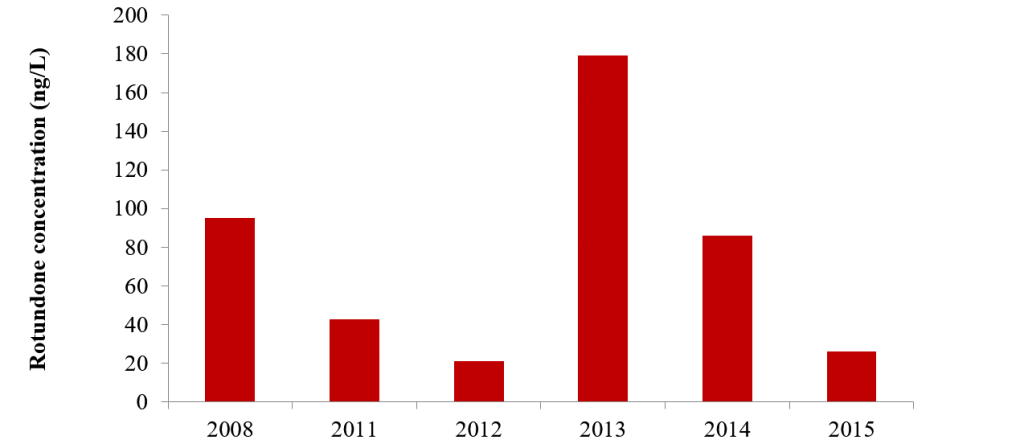
If irrigation has shown its efficiency, it is certainly not a sustainable practice in the long term. To allow winegrowers and winemakers to keep peppering their wine with rotundone, the most promising adaptation strategies could come from plant material. On the one hand, new rootstocks resistant to drought might allow to mitigate these depreciative impacts by enhancing vine vigor and limiting the penetration of solar radiation through the bunch zone in extreme climatic conditions. On the other hand, all the studies on rotundone have been conducted on early ripening cultivars such as Syrah, Gamay or Duras. Existing genotypes or new developed genotypes which can produce rotundone and ripen late in the season under cool climatic conditions, could also prove to be an interesting approach.
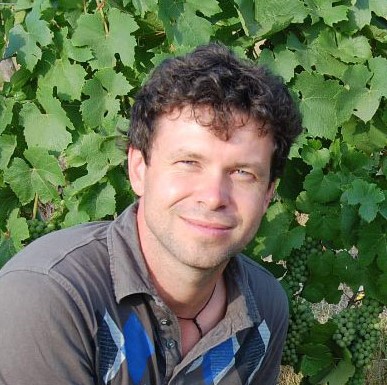
Olivier Geffroy is assistant professor in viticulture and enology at Ecole d’Ingénieurs de Purpan in Toulouse, South West of France. His researches aim at helping winegrowers and winemakers to produce high quality wines. Main topics of investigation includes the impact of viticultural practices (nitrogen spraying at veraison, leaf removal, irrigation…) and enological techniques (fermentation conditions and yeast strains, maceration techniques) on wine aroma. Since 2011, his researches have been focusing on rotundone in red wines.
References:
- Caputi, L., Carlin, S., Ghiglieno, I., Stefanini, M., Valenti, L., Vrhovsek, U. and Mattivi, F. (2011) Relationship of changes in rotundone content during grape ripening and winemaking to manipulation of the ‘peppery’ character of wine. Journal of Agricultural and Food Chemistry 59, 5565-5571.
- Drew, D.P., Andersen, T.B., Sweetman, C., Moller, B.L., Ford, C. and Simonsen, H.T. (2016) Two key polymorphisms in a newly discovered allele of the Vitis vinifera TPS24 gene are responsible for the production of the rotundone precursor alpha‐guaiene. Journal of Experimental Botany 67, 799–808
- Ferreira, V. (2012). Bases moléculaires de l’arôme du vin. In Proceedings of the international symposium on wine aroma (VINAROMAS project), 20 November 2012, Toulouse, France (IFV Sud-Ouest: Lisle Sur Tarn, France) pp. 5–6.
- Geffroy, O., Descôtes, J., Serrano, E., Li Calzi, M., Dagan, L., & Schneider, R. (2018). Can a certain concentration of rotundone be undesirable in Duras red wine? A study to estimate a consumer rejection threshold for the pepper aroma compound. Australian journal of grape and wine research, 24, 88-95.
- Geffroy, O., Siebert, T., Silvano, A., & Herderich, M. (2017). Impact of winemaking techniques on classical enological parameters and rotundone in red wine at the laboratory scale. American Journal of Enology and Viticulture, 68, 141-146.
- Geffroy, O., Buissière, C., Lempereur, V., & Chatelet, B. (2016). A sensory, chemical and consumer study of the peppery typicality of French Gamay wines from cool-climate vineyards. Journal International de la Vigne et du Vin, 50, 35-47.
- Geffroy, O., Yobrégat, O., Dufourcq, T., Siebert, T., & Serrano, É. (2015). Certified clone and powdery mildew impact rotundone in red wine from Vitis vinifera L. cv. Duras N. Journal International des Sciences de la Vigne et du Vin, 49, 231-240.
- Geffroy, O., Dufourcq, T., Carcenac, D., Siebert, T., Herderich, M., & Serrano, E. (2014). Effect of ripeness and viticultural techniques on the rotundone concentration in red wine made from V itis vinifera L. cv. D uras. Australian journal of grape and wine research, 20, 401-408.
- Wood, C., T.E. Siebert, M. Parker, D.L. Capone, G.M. Elsey, A.P. Pollnitz, M. Eggers, M. Meier, T. Vossing, S. Widder, G. Krammer, M.A. Sefton, and M.J. Herderich (2008) From wine to pepper: rotundone, an obscure sesquiterpene, is a potent spicy aroma compound. Journal of Agricultural and Food Chemistry 56, 3738-3744.
- Zhang, P., Barlow, S., Krstic, M., Herderich, M., Fuentes, S., & Howell, K. (2015). Within-vineyard, within-vine, and within-bunch variability of the rotundone concentration in berries of Vitis vinifera L. cv. Shiraz. Journal of agricultural and food chemistry, 63, 4276-4283.

